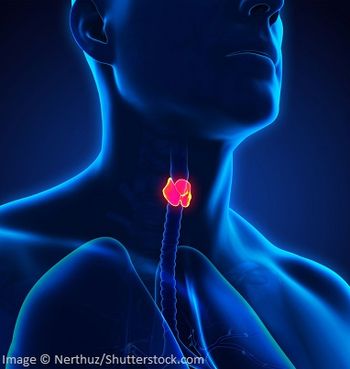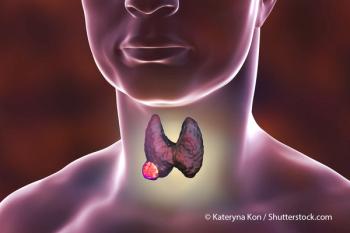
Oncology NEWS International
- Oncology NEWS International Vol 6 No 3
- Volume 6
- Issue 3
Endocrinologists Issue Clinical Guidelines for Thyroid Cancer
NEW YORK--Cancer of the thyroid, a highly treatable disease, is often overlooked in its earliest stages and, once diagnosed, may be treated too aggressively. In an effort to address these issues and to standardize treatment, the American Association of Clinical Endocrinologists (AACE) has published new guidelines for the management of thyroid carcinoma.
NEW YORK--Cancer of the thyroid, a highly treatable disease, is oftenoverlooked in its earliest stages and, once diagnosed, may be treated tooaggressively. In an effort to address these issues and to standardize treatment,the American Association of Clinical Endocrinologists (AACE) has publishednew guidelines for the management of thyroid carcinoma.
At a press briefing, Ian D. Hay, MD, professor of medicine, Mayo MedicalSchool, and co-chair of the AACE Thyroid Cancer Guidelines Task Force,said that the guidelines are intended to resolve current controversy overthe diagnosis and treatment of the disease, with the result that "allpatients will receive high-quality, cost-effective care."
The incidence of undiagnosed thyroid malignancies may be as high as3 million, said Stanley Feld, MD, past president of AACE and co-chair ofthe guidelines task force. Because thyroid cancer is asymp-tomatic, thefirst sign, a suspicious swelling, is usually noted either by a physicianin the course of a routine physical examination or by a patient.
The AACE has recently developed a
Dr. Feld, clinical associate professor of medicine, University of TexasSouthwestern Medical School, Dallas, said that clinical endocrinologistsare uniquely qualified to diagnose the disease and to coordinate comprehensivecare.
The guidelines are intended to avoid overly aggressive treatment ofpatients who are not at risk for recurrence while ensuring adequate monitoringand appropriate adjuvant therapy for those who are at risk.
Diagnosis, according to the new guidelines, should be through fine-needleaspiration (FNA) biopsy, which Dr. Feld termed "the gold standard,the most effective method available for distinguishing between benign andmalignant thyroid nodules." FNA is most effective in diagnosing papillarythyroid carcinoma, by far the most common type.
The guidelines state that the diagnosis should be verified by histologicexamination after surgical excision of affected tissues. Prognosis varieswith tumor type; differentiated tumors (papillary and follicular) are highlycurable while the less common poorly differentiated tumors (medullary andanaplastic) are more likely to be aggressive and metastatic.
For more information about the neck check or to download the clinicalguidelines, contact the AACE web site at
Recommended Treatment
Initial treatment is usually surgical, with near-total thyroidectomythe preferred approach in most instances. In this procedure, the lobe containingthe dominant tumor mass is removed completely; most of the contralaterallobe is removed, with only a minute amount left in place to preserve thevascular supply to the parathyroid glands. Dr. Hay said that radical neckdissection is now considered overly aggressive in most cases.
Postoperatively, all patients receive daily thyroid hormone replacementfor the rest of their lives. For the majority, this is sufficient, thoughperiodic monitoring of TSH levels is essential. For patients at risk forrecurrence, adjuvant therapy is recommended.
Said Dr. Hay, "It is now possible to predict risk of recurrencewith a high degree of accuracy, employing circulating tumor markers (analogousto PSA) and thyroid scans, with the result that aggressive treatment canbe reserved for those who really need it."
Nonradioactive imaging techniques, including ultrasound, are increasinglyused for risk assessment, he added.
Patients must be followed precisely and diligently, and for that reason,Dr. Hay stressed the central role of the endocrinologist in coordinatingcare. "Risk assessment and follow-up should be performed by a clinicalendocrinologist who is trained to monitor thyroid hormone levels, deliverradioiodine (RAI), and test for markers," he said.
Options for adjuvant therapy include thyroid suppressive therapy withlevothy-roxine and remnant ablation with RAI. In the past, Dr. Hay said,RAI was overused and excessively high doses were given. "RAI shouldnot be used routinely, as it could have long-term negative consequences,"he said. External irradiation is used only in rare cases.
Chemotherapy, either mono- or combination therapy, depending on thetumor type, is restricted to patients with unresectable tumors who areunresponsive to RAI and for whom external irradiation is not possible ornot effective.
With publication of the AACE guidelines, Dr. Hay said, "we hopeto eliminate overaggressive treatment for the majority of patients andavoid inadequate therapy for the minority who are at risk for recurrence."The guidelines have been mailed to 150,000 physicians in the United States.
Articles in this issue
almost 29 years ago
Bills Address Women's Health and Cancer Issuesalmost 29 years ago
Possible Evolutionary Advantage Seen in Breast Cancer Genesalmost 29 years ago
Physicians Urged to Listen to Tamoxifen Users' Concernsalmost 29 years ago
Neck Check Exam Aims at Early Detectionalmost 29 years ago
NCAB to Consider Mammography in Fortiesalmost 29 years ago
Fatigue May Be Most Under-recognized, Undertreated Cancer-related Symptomalmost 29 years ago
Hormone Replacement Therapy: Making Informed Decisionsalmost 29 years ago
AHCPR Issues Colorectal Cancer Screening Evidence ReportNewsletter
Stay up to date on recent advances in the multidisciplinary approach to cancer.
































































































